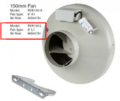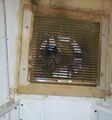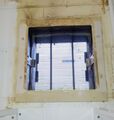Extractor Fan Improvement for Laser Cutter
This page is all about the extractor fan for the Laser cutter.
The laser cutter requires an extractor fan to remove fumes and smoke particles that arise during the cutting process. It shouldn't have to annoy other visitors to Little House or the neighbours in the process, though. This is the documentation of our experience.
A little bit of history
The Chinese laser cutter was originally supplied with an extractor fan. Being made to a low price, it does the job but it's incredibly noisy. We didn't like it in Little House at first because it was difficult to hold a conversation in the same room while it was running.
PaulB made an MDF shelf and enclosure for the extractor fan, stuffed the box with glass-fibre wool and mounted the fan on a vibration-absorbing base. This helped, but it wasn't enough. Then we sealed all the edges with mastic and the quietness was noticeable.
We never went outside to see what had happened to all the noise. The outlet points towards Hornby house which is not far away. The noise of the extractor fan outside is clearly noticeable. Not as bad as a jet plane passing overhead, but it is continuous and irritating. We've not had regular complaints about it but that may be because it runs for a few hours on a few days and only one time each week in the evening.
One Tuesday, we left the laser cutter switched on until 11.30pm. It wasn't being used, but it had not been switched off after the last person to use it had finished. That week we did get a complaint from Hornby House about the noise late into the evening.
Accommodating the Community and Improving Capabilities
We are a community club and we want to be good neighbours. We need to be good neighbours to also qualify for some community space when Ham Close is rebuilt sometime in the future. We want to improve the quality of life for everyone through Making, Mending and Doing Good Deeds in the community.
The question of noise at night was talked over on the maker mailing list, and a good number of opinions were expressed.
...but one of our residents has been complaining about the little house apparently they were working until gone 11pm last week arc welding and the mess and noise was too much probably not helped by the heat and all the windows open but this is a different resident and a difficult one...
...I can only say that on Fridays no work is done outside after 6:00 pm...
...The laser cutter is most used, often with a queue, I don't think that's reasonable...
...but worst of all is the laser cutter extractor. We have it in a soundproofed box. Stand outside and listen, you can understand why people in the end flats of that block might feel irritated...
...Think 9.00pm is much too early, - its our most popular device and there's often a queue for it. Ten O'clock seems like a sensible compromise. Who goes to bed much earlier than that? ...
... 1. Is the extractor balanced? 2. Has it been mounted to the wall in such a way that the wall itself is contributing? ...
...Lots of people in the area have kids who will go to bed before even 9:00pm and there may be shift workers amongst our neighbours, but that is not the whole point. On a warm evening when you are sitting in your living room with the windows open, you don’t want the noise from industrial machinery....
...Possibly ducting the exhaust to the other side and ensuring the extractor was isolated from the fabric of the building would help, but this kind of noise is hard to eliminate...
...Some options: (a) We make a new hole in the wall, not necessarily on the same side as it is now we put a proper chimney pipe that takes the exhaust to eve-height or above. (b) We move the laser cutter within Little House so the noise is on a more socially acceptable side (in conjunction with a new hole/chimney). (c) We buy a different fan. (d) We move the fan into a better designed sound proof box (which might be outside). (e) We build some form of baffle silencer.
...if we can put an acoustic labyrinth within the exhaust pipe and preferably take it to about 400mm above the eves, with the fan isolated on rubber bungs this should reduce the noise quite a bit and have it on the more socially acceptable side of the building. I would still say that a 9:00pm cut off is necessary for all external noise though...
...The supplied fan is truly awful, and it would not hurt us to spend one or two hundred pounds on a modern, efficient extractor fan with electronic speed regulation...
...Trotec has a simlar size machine: We can imply a 350m³/hr fan would do it. A suitable thing is at TLC https://www.tlc-direct.co.uk/Products/SLTD350SILENT.html ...
...Once that's confirmed I believe we are agreed to buy a new fan of the type suggested by Chris, we might also need some ducting, which might be easiest sourced from Screwfix 'round the corner off Richmond Road.
...I wouldn't buy anything without checking what's there already and double checking that the route I went down to arrive at the TLC fan actually holds water. What specs do we have on the existing fan? ...
At present, we are implementing a 9:00pm cutoff time for laser cutter work on Tuesday evenings. It would be possible to open up an hour or two before 7.30pm to allow early birds to get some cutting done sooner.
It seems a sensible move to replace the extractor fan with a good-quality 'silent' fan. It won't be literally silent, but it should be a considerable improvement on what we have at present.
When doing the replacement, we can completely remove the old broken Vent-Axia wall-fan, and fill the hole in the wall with a wooden plate cut to allow the ducting through.
Selecting a replacement extractor fan
I (IanB) contacted the fan manufacturer Soler & Palau asking about the difference in noise levels between a TD extractor and a TD-Silent extractor. Also, with these fans being designed for low noise at the inlet, would they be quiet at the outlet also?
I understand that the need for the laser extractor is to move 350 cu.m of air per hour. I can't remember where I got that information from, so I can't say that it's an accurate requirement.
The manufacturer said: Thank you for your enquiry and your interest in S&P.
The TD-350/125 Silent fan is able to provide just about 330m3/h, but in free air with no resistance.
Since it’s an inline fan I would expect a system resistance when the fan is installed in the duct.
Depending on the resistance the airflow will be less. See attached performance chart.
Maybe you should go with the next size up and slow it down via a speed controller if needed.
The next size fan will be TD-500/150-160 Silent 3V. It has 3-speed motor fitted, so it can be speed controlled via either 3-speed selector switch or electronic speed controller.
I can confirm that the TD-Silent model is less noisy at the inlet / outlet than the regular Mixflow version fan. Also, the radiated noise level is quite different.
Since you didn’t mention the noise levels needed I sent you the data sheet showing the full spectrum noise level for the Silent fan.
Please find a data sheet for TD-350/125 Mixflow fan for comparison.
Well, the representative would, of course, recommend that you get a bigger fan than the one you are looking for. But it's worth considering. A big fan running at a medium power setting could be quieter than a small fan running at full power. S&P haven't got any data to answer that question.
Note that these TD-Silent fans have wall mounting brackets and they incorporate vibration absorbers in the motor mount brackets.
At present, I envisage the outlet ducting going through the wall and just dangling down at 90 degrees, facing the grass. If the air passed through a grille it would create some degree of hissing. We could smarten up the outside appearance of the duct by putting a box over the 90 degree turn, a box with an open bottom.
Sound power levels and prices
The figures are LwA, i.e. the A-weighted emitted sound power levels
| Fan | Duct Size | Inlet port | Outlet port | Price |
|---|---|---|---|---|
| TD-Mixvent 350 | 125mm | 58 | 59 | £95.39 |
| TD-Silent 350 | 125mm | 56 | 54 | £116.85 |
| TD-Silent 500 | 150mm | 57 | 57 | £154.60 |
The port in the side of the laser cutter is for 150mm ducting. The existing noisy extractor fan has ports for 150mm ducting. The lengths of ducting we already have are 150mm diameter. To convert to 125mm, add £20.00 for a length of flexible hose ducting and £2.00 for a reducer to fit the laser cutter exhaust port.
One more thought
If we select a three-speed extractor fan, and if we can take a feed from the laser cutter control box, the extractor could run at lowest power while the laser cutter is switched on, then step up to full power while it's actually cutting. With a tiny bit more control, the extractor could be made to run-on at full power for three minutes after the laser cutter has stopped cutting, to ensure all the fumes have been purged.
Next step
Let's jointly come to a decision and get a fan on order. Let's get any accessories we need and set a day/evening for doing the changeover. Let's get on with it!
- Measuring dB We have confirmed that the noise level right outside the extractor is higher than 90dB. According to our tools.
- Localisation of the noise We have confirmed that it is highly directional so we could install a pipe to aim the noise in another direction. Or, worst case scenario, move the laser cutter to the office space.
- Measuring flow Chris R. has ordered a flow meter. Most of the research shows that there is little documentation on this front.
- 'Bed size it is 700 to by 500 mm or approximate A2 size or 32 inch by 20 inch in American standard. It was found that the more modern versions of laser cutters hava a way to adjust the flow depending on the size of the part being cut.
- 'Asking the community Direct question and some related questions and Reading hackspacein the community
- Calculated flow The laser cutter measures 1160 x 870 x 500mm, which is 0.5 cu.m. Suppose the fan could move 0.5 cu.m in 5 seconds, that's 0.1 cu.m per second, 6 cu.m per minute, 360 cu.m per hour.
- Companies contacted : Chris R. has contacted several companies asking for their recommendations.
- Sound dampening : Speaking to Paul S. He recommended using plywood for the box also using a "Sound ladder", "acoustics ladder", (for got the name!) basically a way to break the noise in the output.
- Existing fan: there is already an existing fan (not currently working) which needs to be removed: this came with the building, the fan was broken and has been removed.
- The general consensus: is that a more modern fan extractor should do the trick.
Chris R. Report 2018-09-18
Progress on a fan 18-09-2018. Dropswell Lasers is a company which appear to import Chinese cutters and resell them in packages. Their “6040” model isn’t far off ours. A guy there told me what type of fans they use, even where they get them from. He was very confident – just “Get the flow rate about the same, don’t go too much lower, but it’s only smoke”.
The flow rate on our fan data plate:
says 870m³/hr which is higher than I’d seen for a similar (?) Trotec machine.
I measured in the inlet hose, 680 m³/hr with the fan as we were using it. 770 m³/hr without the cutter or the outlet grill attached (only the inlet hose).
Duct fans vary for the same flow rate, in static head, dynamic head, noise, electrical efficiency, size (diameter) and more, including quality of course.
The suggested fan type is shown as SystemAir RVK on this page which has some info behind it: https://www.onestopgrowshop.co.uk/t/categories/fans-filters-and-air-control/duct-fans The 6 inch L 150mm 720 m³/hr at 44.8dB looks suitable. The price there is £82.95. It’s a very common and highly respected fan which is available elsewhere, (down to £66 but look for the mounting plate which we do need). Eg https://www.amazon.co.uk/Systemair-RVK-150mm-Ducting-Hydroponics/dp/B00JNFL0N4
I spoke to One-stop about options. The Ram Air type is smaller and more efficient but noisier and not as well made. The Ram Air model is typical of a variation which has a more centrifugal fan action which leads to the smaller size, higher electrical efficiency at the cost of noise. They’re very common, usually called something like “Mixed flow”. They usually cost £150 upwards. NB Flow specs change depending what pressure is specified.
If we need more flow we could use a larger diameter and adapt it down to 150mm. Our duct is very short, for a hydroponic-growing application, they normally have higher resistance.
-
Extractor that came with Fan.
-
Flow Diagrams.
-
Fan extractor insides.
-
Old axial fan that was in the way.
-
After axial fan removed.
Considering all, I think the RVK 150L would be a sensible buy. We could sell it and go bigger if necessary. It’s a bit bulky, but no bigger than our existing fan.
NB Flow depends on resistance. NB 0.16 m³/s is 576 m³/hr. Figures vary.
While I was there I checked the outlet – it was gooked up on the inner grille of the dead VentAxia fan, so I dewired it and took it out:
I replaced the old “bezel” as it may be useful later for holding a plate. (There are also two associated bits of wood on top of the fan box which share the same screw fixings.)
The obstruction on the fan outlet had been making a lot of high frequency noise, which I reproduced with the fan running when removed and partly obstructed. Two phones read 80dB at the outlet outside, where I’d previously recorded 90dB with Paul’s meter.
I have a few further details – contact me if .. etc. CR.
Conclusion
See Blog_2018#2018-10-03_Wednesday Under £100 spent on wood, and fan extractor. Flow on the fan is 605 m^3/hr and seems good enough for this size bed. We would recommend of others of the same size. Actual measured and calculated flow is 530 m^3/hr.
3 hrs looking at internet + 1 hour to put fan on wall + 1 hour to put fan out + 2*2 hours to put the fans + 3 hours driving there and back to take it + 2 hours of documentation + etc etc
Thank you very much Chris for your hard work. Thank you Ian for documenting the work and thank you every body else with your patience.
Updated conclusion 2019-11-11
Fan – yes it was an RVK150 L1 – the higher rating of the two 150mm RVKs which were available at the time. (The Eco was lower flow). Note that there are several similar-looking, similarly described fans out there. The link to Amazon on the https://wiki.richmondmakerlabs.uk/index.php/Extractor_Fan_Improvement_for_Laser_Cutter report is now wrong, as it points to a Blauberg fan. That IS the one they first delivered. I sent it back as it’s a lower output. The one we have was the best output for the size and noise it made.
The RVK we have achieved ~20% lower flow than the fan it replaced (ours claimed 660m3/hr though the literature it came with said a bit less), and it has dropped since I put it in. It now measures about 420m^3/hr. (The originally supplied fan achieved 680m^3/hr). We could try cleaning it. NB that’s quite a bit less than the label says – claims are overstated of course. It seems to do the job but eg smoke from some wood lingers noticeably. The cutter head is fanned separately, but smoke getting onto the mirrors could be an issue, or maybe not if it just gets burned away.
From what I‘ve seen I would investigate the noise output from the 8”/200mm RVK or one such as here: https://www.onestopgrowshop.co.uk/products/ram-mixed-flow-inline-fan-two-speed?taxon_id=49 The maximum diameter doesn’t look larger than the one we have, and the output is much higher. It’s easy to reduce to 150mm. That would reduce the flow some, but the motor is higher power. The speed can be controlled if noise is a problem. Note than some folk wanting to keep their growing activities undetected, entomb these fans in a cube filled with sound insulation. I guess they’d keep quiet if it went wrong, though :).
Note also you’ll find people online calculating the machine clearance time from its volume. That’s not valid; the air will lurk in nooks and crannies for an indeterminate time, and clear faster where it’s easier.
There’s a vid here https://www.youtube.com/watch?v=qHclUKSMzqY which shows a later version of our cutter with an identical-looking original fan which he discusses at about 27 minutes in. He goes on to show his replacement which is a MUCH lower flow fan. He measures the sound pressure incompetently, it should be at the same distance and orientation of course.




